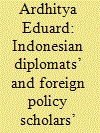| Srl | Item |
| 1 |
ID:
148500


|
|
|
|
|
| Summary/Abstract |
John Mearsheimer has compared China’s attitude towards the South China Sea to the Monroe Doctrine of the United States. Mearsheimer does not accord international law much weight and certainly does not regard it as determinative of political outcomes. But many observers of China’s disputes in the South China Sea look to international law for rules and processes that could facilitate peaceful resolution of the disputes. In doing so they are variously puzzled, bemused, and/or angered by China’s assertion of the nine-dash line (南海九段线). This article draws more broadly on the literature on the Monroe Doctrine, viewing the doctrine as: a unilateral pronouncement of foreign policy; representing resistance; embedded in domestic as opposed to international law; and an assertion of legitimate regional hegemony. Through applying the analogy of the Monroe Doctrine, the article seeks fresh insights into China’s legal position in relation to the South China Sea and into the significance of the nine-dash line in terms of international law.
|
|
|
|
|
|
|
|
|
|
|
|
|
|
|
|
| 2 |
ID:
189249


|
|
|
|
|
| Summary/Abstract |
The question of whether China’s rise to power will be peaceful cannot be evaluated without considering the actions of other major powers. Therefore, this study seeks to explore how Indonesia formulates its response to a rising China. Although previous studies have recognized the importance of perception in shaping Indonesia’s strategic response toward China, previous scholarship has not achieved a systematic investigation of Indonesians’ perception of a rising China. Therefore, this study applies image theory from international relations scholarship to carry out a qualitative content analysis of empirical data collected during interviews with Indonesian diplomats as well as foreign policy scholars. This study finds that perceiving China as presenting a degree of threat rather than opportunity is the dominant perceptual trend among individuals in this study sample. The relatively moderate degree of threats from China were characterized more as economic exploitation and political subordination, than as military attacks or occupation. However, these should be evaluated alongside findings that those individuals are more perceptually sophisticated in their approach to understanding China. This finding therefore suggests, that in the foreseeable future, Indonesian foreign affairs bureaucracy will hardly encourage Jakarta to notably shift Indonesia’s orientation toward the rising power.
|
|
|
|
|
|
|
|
|
|
|
|
|
|
|
|
| 3 |
ID:
091768


|
|
|
|
|
| Publication |
2009.
|
| Summary/Abstract |
The transition of power to a new administration in the United States demands that Washington more clearly articulate its strategy in a changing international situation. One of the key theatres of U.S. global strategy, it would seem, is the Asia-Pacific Region. Recent works by American political scientists allow us to speculate that the White House will follow a more balanced policy in its relations with such East Asian economic powers as China, Japan, South Korea, and the ASEAN countries.
|
|
|
|
|
|
|
|
|
|
|
|
|
|
|
|